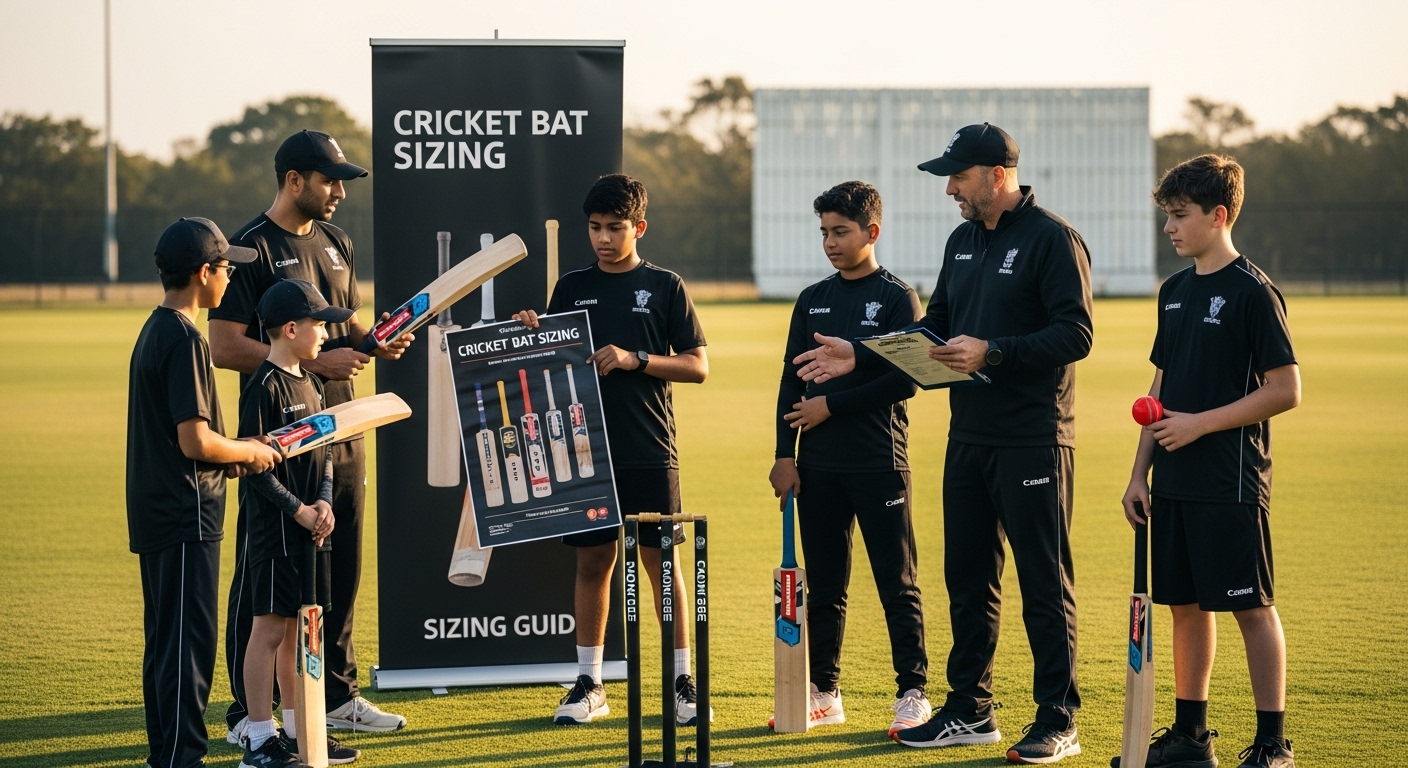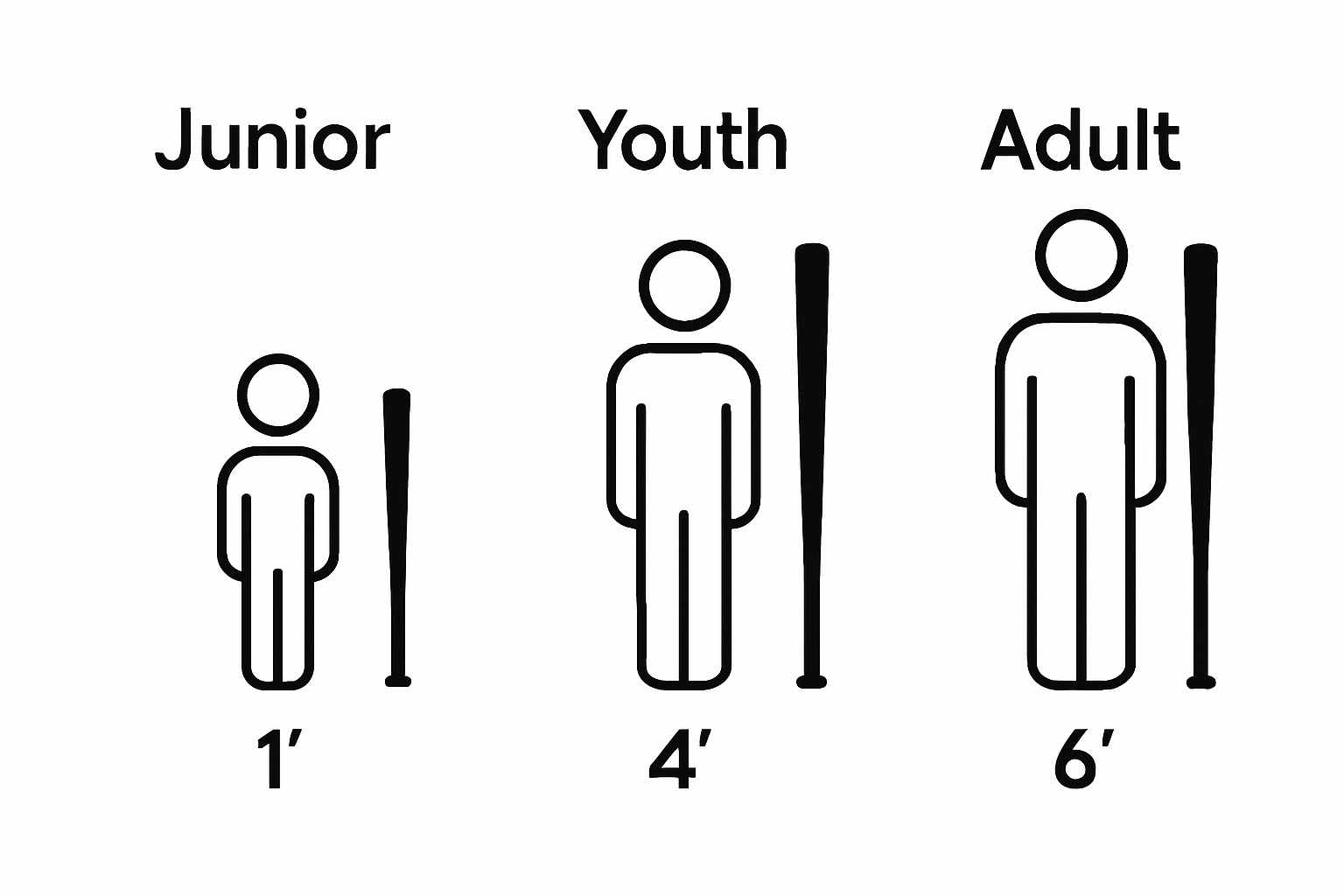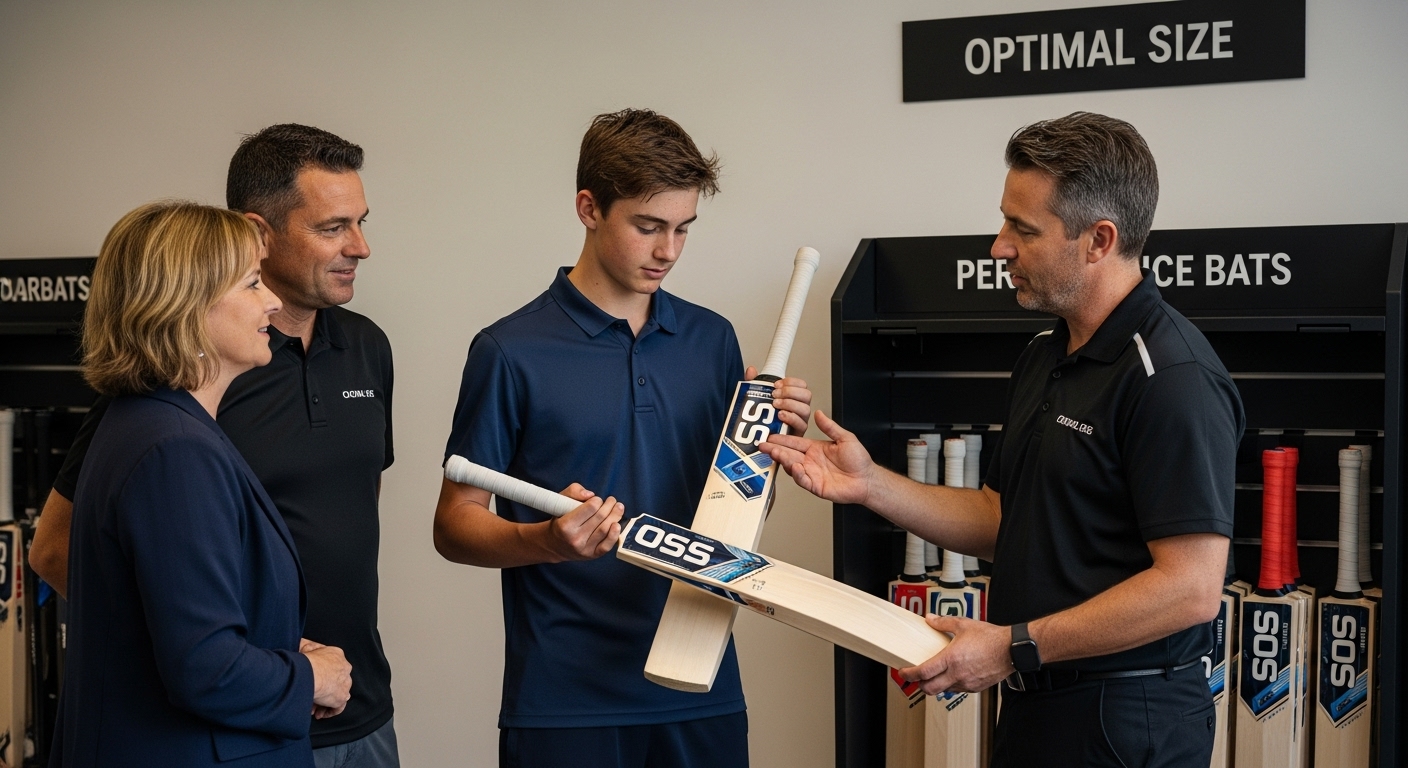Understanding Cricket Bat Sizing Guide for Players

Cricket bat sizing shapes everything from a player’s swing power to their risk of injury. Most buyers grab the biggest or heaviest bat thinking bigger means better. But the data surprises most people. Professional cricket bats can differ by up to 10 inches in length and 8 ounces in weight yet even tiny variations can totally change shot control and power. The real secret is not in having the largest bat but picking one designed for your height, strength, and style. That is where the biggest improvements in performance actually come from.
Table of Contents
- What Is Cricket Bat Sizing And Why Is It Important?
- How Cricket Bat Size Affects Player Performance
- Key Measurements: Understanding Length, Width, And Weight
- Choosing The Right Bat: Age, Height, And Playing Style
- Common Misconceptions About Cricket Bat Sizes
Quick Summary
| Takeaway | Explanation |
|---|---|
| Cricket bat sizing is crucial for performance | Proper sizing enhances shot precision, control, and reduces injury risk. It aligns with a player’s physical traits and skills. |
| Key bat measurements include length, weight, and width | Essential measurements, like bat length and width, affect technique and comfort. They should suit individual player characteristics. |
| Bigger bats are not always better | A heavier or longer bat doesn’t guarantee better performance; it must fit the player’s strength and technique. |
| Match bat to physical development and playing style | Young players need specially designed bats for their growth. Each player’s unique style dictates specific bat requirements. |
| Biomechanics are key in bat selection | The relationship between bat dimensions and player biomechanics is critical for optimizing performance and ensuring comfort during play. |
What is Cricket Bat Sizing and Why is it Important?
Cricket bat sizing represents a precise method of matching a player’s physical characteristics and skill level with the most appropriate cricket bat dimensions. The process involves selecting a bat that not only complements a player’s height, strength, and playing style but also enables optimal performance and technique development.
Understanding Bat Measurements
Cricket bat sizing encompasses several critical measurements that determine a bat’s suitability. These measurements typically include the bat’s length, width, weight, and handle specifications. According to research from Imperial College London, the precise engineering of cricket bat dimensions can significantly influence a player’s batting performance and technique.
Key measurements players should consider include:
- Total bat length (ranges from 28 to 38 inches)
- Blade width (maximum 4.25 inches according to cricket regulations)
- Handle thickness and grip comfort
- Overall bat weight
Performance and Technical Implications
Proper cricket bat sizing directly impacts a player’s ability to execute shots effectively, control ball trajectory, and maintain consistent technique.
An incorrectly sized bat can lead to reduced batting efficiency, increased risk of injury, and potential technical limitations.
Players looking to understand more about selecting the right equipment can read our comprehensive guide on choosing cricket bats. The right bat acts as an extension of the player’s body, facilitating smoother movements, enhanced shot precision, and improved overall batting performance.
Whether you are a junior player developing fundamental skills or an experienced cricketer seeking optimal equipment, understanding cricket bat sizing is crucial for maximizing your potential on the field.
How Cricket Bat Size Affects Player Performance
Cricket bat size plays a crucial role in determining a player’s overall performance, influencing everything from shot precision to physical comfort during gameplay. Understanding the intricate relationship between bat dimensions and player capabilities helps athletes optimize their equipment selection.
Biomechanical Impact of Bat Dimensions
The physical characteristics of a cricket bat directly interact with a player’s biomechanical capabilities. According to research from the University of Bath, bat design significantly affects hand loads and center of percussion, which ultimately determines shot quality and player comfort.
Key biomechanical considerations include:
- Weight distribution across the bat
- Handle thickness and grip ergonomics
- Moment of inertia during swing
- Balance point relative to player’s physical strength
Performance Optimization Strategies
Selecting the right bat size enables players to maximize their technical potential. Bat dimensions should complement a player’s height, strength, and playing style, creating a seamless extension of their physical capabilities. For players looking to explore advanced bat selection techniques, check out our guide on top cricket bats for big hitters.
Players must recognize that an improperly sized bat can significantly compromise their performance. Oversized bats might feel unwieldy, reducing shot control, while undersized bats can limit power generation and create unnatural batting mechanics.
Technical Performance Metrics
The relationship between bat size and player performance extends beyond physical comfort. Bat dimensions directly influence power transfer, shot trajectory, and overall batting technique. Professional cricketers meticulously select bats that provide optimal weight distribution, enabling them to generate maximum power with minimal physical strain.
Ultimately, cricket bat sizing is a nuanced process that requires careful consideration of individual player characteristics, technical skills, and performance objectives.
Key Measurements: Understanding Length, Width, and Weight
Cricket bat measurements represent a precise science that balances performance, regulation, and individual player requirements. These critical dimensions determine a bat’s overall effectiveness and a player’s potential to execute shots with maximum power and precision.
Bat Length Specifications
Bat length is fundamental in determining a player’s reach, shot execution, and overall batting technique. According to research published in the MRS Bulletin, standard cricket bat lengths range strategically to accommodate different player physiques and skill levels.
Typical bat length categories include:
- Junior bats: 28 to 32 inches
- Standard adult bats: 33 to 36 inches
- Professional performance bats: 36 to 38 inches
Width and Weight Considerations
Bat width is strictly regulated in professional cricket, with a maximum blade width of 4.25 inches. Weight variations significantly impact a player’s batting dynamics. Modern cricket bats typically range between 40 to 44 ounces, with professional players sometimes using bats approaching 48 ounces.
Key weight distribution factors include:
- Balance point relative to handle
- Materials used in construction
- Player’s physical strength
- Intended playing style
Performance Engineering
Bat measurements are not arbitrary but carefully engineered to optimize performance. For players seeking advanced insights into equipment selection, explore our comprehensive guide on cricket bat designs.
The interplay between length, width, and weight creates a complex biomechanical relationship. Professional cricketers understand that minor measurement variations can dramatically influence shot power, control, and overall batting technique.
The table below highlights key measurement categories for cricket bats, summarizing their specifications and their significance for player selection and performance.
| Measurement | Typical Range | Regulatory Limit | Importance for Players |
|---|---|---|---|
| Bat Length | 28–38 inches | 38 inches (max) | Influences reach, shot technique, and comfort |
| Blade Width | Up to 4.25 inches | 4.25 inches (max) | Affects shot control and complies with rules |
| Bat Weight | 40–44 ounces (typical) | N/A | Impacts swing speed, power, and fatigue |
| Handle Thickness | Varies (ergonomic comfort) | N/A | Improves grip comfort, control, and reduces strain |
| Balance Point | Varies by design | N/A | Optimizes power transfer and maneuverability |
Choosing the Right Bat: Age, Height, and Playing Style
Selecting the perfect cricket bat involves a complex interplay of physical attributes, skill level, and individual playing characteristics. This nuanced process goes far beyond simple measurements, requiring players to understand their unique biomechanical profile and performance potential.
Age and Physical Development Considerations
According to research in the Open Access Journal of Sports Medicine, bat selection critically depends on a player’s age and physical development. Junior players require specially designed bats that accommodate their growing physique and emerging technical skills.
Bat selection guidelines by age group:

- Under 10: Lightweight bats with shorter handles
- 11 to 14: Progressive bat sizes matching height increases
- 15 and above: Adult-standard bat dimensions with performance optimization
Matching Bat to Playing Style
Each batting style demands unique equipment characteristics. Aggressive power hitters might prefer heavier bats with larger sweet spots, while technically precise players might opt for lighter, more maneuverable options. For specialized bat recommendations, explore our guide to cricket bat designs.
Key playing style considerations include:
- Batting position (opener, middle order, finisher)
- Preferred shot types
- Individual strength and technique
- Preferred batting surface conditions
Anthropometric Precision
Height and arm span are critical determinants in bat selection. Professional players meticulously match bat dimensions to their physical proportions, ensuring optimal control and power generation. For instance, taller players might benefit from slightly longer bats, while shorter players could require more compact designs.
Ultimately, choosing the right cricket bat is a personalized journey that balances scientific measurement with individual feel and performance potential.

Common Misconceptions About Cricket Bat Sizes
Cricket bat sizing is surrounded by numerous myths and misunderstandings that can significantly impact a player’s equipment selection and performance. Understanding these misconceptions helps players make more informed decisions about their cricket bat choices.
This table outlines common misconceptions about cricket bat sizes and provides accurate clarifications based on current research and professional insights.
| Misconception | Explanation/Reality |
|---|---|
| Bigger or heavier bats guarantee more power | Weight must match a player’s strength and technique for best results |
| Longer bats provide better reach for all | Bat length should be based on individual height and playing style |
| Maximum allowable size is always optimal | Optimal bat size varies per player, not always the largest allowed |
| All bats feel the same once used | Subtle differences in dimensions significantly affect performance |
| Regulations are just about length and width | Regulations consider materials and design for fairness |
| One-size-fits-all works for bat selection | Personalized bat fitting is critical for comfort and performance |
Bigger Always Means Better
Contrary to popular belief, a larger bat does not automatically translate to superior performance. According to research from the Proceedings of the Institution of Mechanical Engineers, modern bat designs have evolved to optimize performance through precise engineering, not simply by increasing size.
Common size-related misconceptions include:
- Heavier bats guarantee more power
- Longer bats provide better reach for all players
- Maximum allowable size is always the best choice
- One-size-fits-all approach works for bat selection
Weight and Performance Myths
Many players mistakenly believe that the heaviest possible bat will generate maximum power. In reality, bat weight must be carefully balanced with a player’s physical strength and technique. For insights into selecting the right bat online, explore our comprehensive guide.
Key performance considerations players often overlook:
- Individual strength and batting technique
- Bat balance and weight distribution
- Personal comfort and control
- Specific playing conditions
Regulatory Misunderstandings
Cricket bat regulations are more nuanced than many players realize. The Marylebone Cricket Club has implemented specific guidelines to maintain fairness in equipment design. Professional players understand that bat selection involves complex biomechanical considerations beyond simple size measurements.
Ultimately, choosing the right cricket bat is a personalized process that requires understanding individual playing characteristics, technical skills, and performance objectives.
Find Your Perfect Cricket Bat and Play Your Best Game
Struggling to match your playing style and physical needs with the right cricket bat size? As you learned in our sizing guide, a poorly chosen bat can affect your performance and even increase your risk of injury. Serious players and juniors alike often feel overwhelmed by confusing specs, uncertain if their gear helps or hinders their progress. A bat that suits your age, strength, and skill can make every shot feel natural and give you true confidence at the crease.

Stop guessing and start playing with gear designed for you. At CricketKingdom.co.uk, you can explore a huge selection of bats engineered for all heights, ages, and technical needs. Enjoy free shipment on orders over £100 and get professional touches like free knocking and oiling for high-value bats. Take advantage of convenient payment options and see why customers rate us for quality and service. Your game deserves elite equipment that empowers your best performance. Visit CricketKingdom.co.uk now and choose the cricket bat that fits your game and goals.
Frequently Asked Questions
What is cricket bat sizing?
Cricket bat sizing is the process of selecting a bat that matches a player’s physical characteristics, skill level, and playing style to optimize performance and technique development.
How do bat measurements affect performance?
Bat measurements, such as length, width, and weight, directly influence shot precision, control, and overall batting technique, impacting a player’s ability to execute shots effectively.
What are the key measurements to consider when choosing a cricket bat?
Key measurements include total bat length (ranges from 28 to 38 inches), blade width (maximum 4.25 inches), handle thickness, grip comfort, and overall bat weight, typically ranging between 40 to 44 ounces.
Why is it important to select the right bat for my playing style?
Selecting the right bat for your playing style ensures optimal weight distribution and balance, allowing for better power generation and shot control, which directly affects performance on the field.
Recommended
- How to Choose Cricket Bat: A Step-by-Step Guide for Players – The Cricket Kingdom
- Top 10 Cricket Bats for Big Hitters – The Cricket Kingdom
- SG Bats Guide: Top Choice for Cricketers – The Cricket Kingdom
- Essential Cricket Equipment in the UK: Must-Have Gear for Every Cricketer – The Cricket Kingdom


